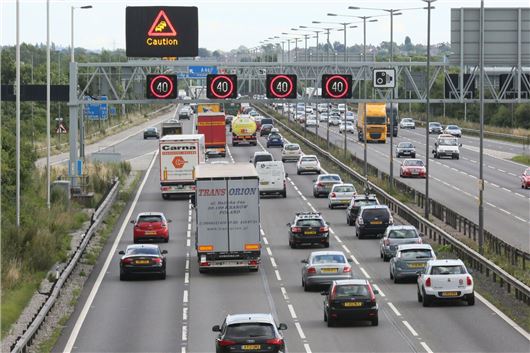£5m boost to make smart motorways safer

Following heavy criticism of smart motorways, Transport Secretary Grant Shapps has released a new report detailing 18 measures to improve safety. The points include £5m funding increase and scrapping the opening of the motorway's hard shoulders for traffic at busy times.
Thirty-eight people have been killed on Smart Motorways over the past five years, with one section of the M25 seeing a 20-fold increase in the number of potentially fatal “near misses” involving stationary vehicles since the hard shoulder was removed in 2014, according to an investigation by BBC Panorama.
There are more than 400 miles of Smart Motorway in the UK and the majority are designed to relieve congestion by making the hard shoulder available for use of traffic. On some motorways the hard shoulder is opened at busy times while others use it permanently - known as all lane running (ALR).
Shapps said, "Overall, what the evidence shows is that in most ways, smart motorways are as safe as, or safer than, the conventional ones. But not in every way."
In addition to abolishing the dynamic hard shoulder, the government has said it will also reduce the distance between places to stop in an emergency to three quarters of a mile where possible. It says this will mean on future schemes, motorists should typically reach a stop every 45 seconds at 60mph. The maximum spacing will be one mile.
"Overall, what the evidence shows is that in most ways, smart motorways are as safe as, or safer than, the conventional ones. But not in every way. Smart motorways have helped us cope with a 23 per cent rise in traffic since 2000. They save motorists thousands of hours sitting in jams. They reduce the disruption and environmental destruction which would otherwise be needed to widen our busiest roads," said Transport Secretary Grant Shapps.
The government's plan also includes measures to:
- Install 10 additional emergency areas on the existing M25 smart motorway section
- Speeding up the deployment of technology to detect 'stopped vehicles'
- Making emergency areas more visible
- investigating M6 Bromford viaduct and the M1 at Luton, Sheffield and Wakefield where there is evidence of clusters of incidents. Where an intervention is considered likely to make a difference, we will look to make changes at these locations
- making emergency areas more visible – all emergency areas will have a bright orange road surface, dotted lines on the surfacing showing where to stop, better and more frequent signs on approach and signs inside giving information on what to do in an emergency. These will be installed by the end of spring 2020
- displaying ‘report of obstruction’ messages automatically on electronic signs, triggered by the stopped vehicle detection system, to warn drivers of a stopped vehicle ahead, this is currently being trialled on the M25 and then a further trial on the M3
- we have changed the law to enable automatic detection of ‘red X’ violations and enforcement using cameras and we will be expanding the upgrade of smart motorway cameras (HADECS) to identify more of those who currently ignore the ‘red X’. The penalty is 3 points on the driver’s licence and a £100 fine, or the driver can be referred to an awareness course
"We don’t believe the main issue at hand here is the safety of smart motorways with ‘dynamic’ hard shoulders [...]. The safe running of any smart motorway heavily depends on drivers being able to see, and react to red X signage indicating where lanes are closed.
"We are disappointed that the review has not looked at the spacing of red X gantry signage as we believe in too many instances signs are spaced too far apart, increasing the possibility of drivers not seeing them," said RAC head of roads policy, Nicholas Lyes.

 Georgia Petrie
Georgia Petrie
 Honest John Awards 2017: Land Rover Discovery Sport named Most Popular SUV for second year in a row
Honest John Awards 2017: Land Rover Discovery Sport named Most Popular SUV for second year in a row
 2022 Smart #1 SUV: price, specs and release date
2022 Smart #1 SUV: price, specs and release date
 2023 Ferrari Purosangue SUV: Prices, specs and release date
2023 Ferrari Purosangue SUV: Prices, specs and release date
 Citroen DS3 Racing revealed
Citroen DS3 Racing revealed
 Infiniti adds diesel to the range
Infiniti adds diesel to the range
 Volvo XC90 chosen as SUV of the year at 2014 Honest John Awards
Volvo XC90 chosen as SUV of the year at 2014 Honest John Awards
 March new car registrations better than expected
March new car registrations better than expected

.jpg)






gavsmit on 13 March 2020
That's a lot of money for a pot of paint and a paintbrush.DLDLDL on 14 March 2020
The report reads as a whitewash for "Smart Motorways" a.k.a. "Dumb Cheapskate Motorways". It bears careful reading.
It tries to say that All Lane Running Smart Motorways (those without Hard shoulders but with overhead gantries etc) are safer than Conventional Motorways, therefore it is proven that removing the Hard shoulder increases safety.
However look carefully and you can see that "Controlled Motorways" (those with gantries etc AND hard-shoulders) are safer than both All Lane Running and Conventional Motorways.
From Page 43:
hmvm = Hundred Million Vehicle Miles DHS = Dynamic Hard Shoulder (signal controlled Hard Shoulder Running) ALR = All Lane Running (no hard shoulder)
So it would appear that it is the provision of the "Controlled Motorway" hardware (gantries, speed cameras, anti-tailgating cameras etc) that bring the safety improvement (we drive more responsibly and within the speed limits when being observed); ALR then reduces safety because of the greater danger of "Live" Lane stopping becoming death lane stopping.
The report glosses over this - no doubt fearful of the conclusion that ALR has been recklessly introduced and that re-introducing a hard shoulder (not just for emergency stopping but also for emergency access) will increase safety.
As for "Hard shoulders are dangerous; 1 in 12 deaths occur on the hard shoulder"; think about it. Presumably 11 in 12 deaths are occurring in the 2,3, or 4 running lanes. If I had to stop I would want it to be on a hard shoulder not a running lane.
Serious and Fatal Accidents occur more frequently on All Lane Running Stupid Motorways, than on either Controlled Motorways or Dynamic Hard Shoulder Motorways (see above). So the government proposes to convert all DHS motorways to All Lane Running "to avoid confusion".
They also seem to say that the "places of relative safety" are safer than the hard shoulder because they are wider. True they are wider, but given that they only occur every mile or so, there is a lot of motorway where the place of relative safety is zero feet wide!
The places of relative safety are also quite short at about 100 metres (including tappers at either end). Stopping distance at 50mph in good conditions is 50+ metres - not really enough for both a casualty vehicle and a rescue vehicle to get into the full width part of the "place of relative safety".
The proposal to have such places start every 3/4 of a mile "where possible" is insufficient. With the need to signpost such places (with countdown boards etc.) adding to the clutter that assails the concentration of drivers, you do wonder whether it might be better to make each place of relative safety itself 3/4 mile long - but that would represent a return to continuous hard shoulders and a policy reversal. And that would never do!
If you have a blow out in lane 4 (or even 5) how much distance do you need to get over to the nearside lane? Do you then want to have to struggle another 3/4 mile plus to the next "place of relative safety"?
This report is a self-justification of a dangerous (and deceitfully created) status-quo where motorway safety is being reduced by penny pinching.
Former minister, Sir Mike Penning told the BBC he was misled about the risks of removing hard shoulders.
Edited by DLDLDL on 14/03/2020 at 15:13
gordonbennet on 15 March 2020
Another whitewash, well done Saul just the result we wanted, here have a knighthood.Refuges too far apart at 3/4 mile (where possible) anyway and what the dickens difference will it make painting them orange instead of yellow, you can't see the things if in dire need because of the lines of lorries in the two nearside lanes at the best of times.
It would help if they had floodlighting over the refuges, more chance of finding one at night, and they need to be longer than the present dimensions, ideally joining them up to form a continuous safety lane:-) which isn't as daft as it sounds, no need to widen bridges because we can cope with a few hundreds yards of hard shoulder missing every few miles, its the present issue where a place of safety is every few miles instead.
The M1 Milton Keynes to Northampton section is nearing completion by the look of it, someone please tell me these new refuges are going to be constructed in all places stil under cnstruction whilst the chaps and the equipment and the endless cones are still in place...no i won't hold me breath for some common sense to be found among the mandarins.
Add a comment